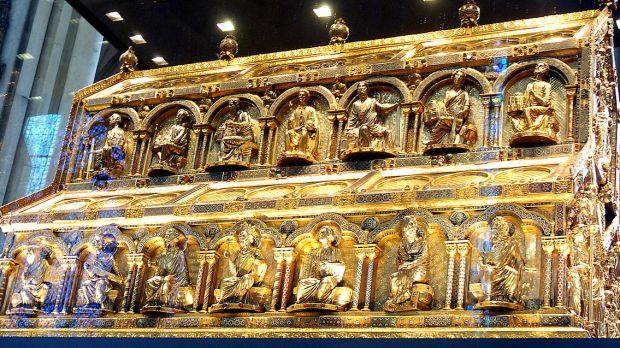Is it possible that the bones of the Magi — Balthasar, Melchior and Caspar — are kept in a golden tomb in the largest Gothic cathedral in Europe? An ancient tradition recounts the tale of how the bodies of the Magi who visited the Christ child found their way to their final resting place in Germany’s Cologne Cathedral.
The story is told in 14th-century John of Hildesheim’s Historia Trium Regum or “The History of the Three Kings.” John says Balthasar, Melchior and Caspar were from India, Persia and Chaldea (present-day Iran and Iraq). They set off separately, met at the birthplace in Jerusalem and then journeyed together to Bethlehem. After worshiping Christ, they returned together to India, where they built a church, and after another vision that revealed that their earthly life was about to end, they died at the same time and were buried in their church in India.
Two hundred years later, John of Hildesheim explains, St. Helena, the mother of the emperor Constantine, traveled to India and recovered their bodies. She put them into a beautifully ornamented casket and placed them in the great church of St. Sophia in Constantinople. In the late 6th century, the emperor Mauricius had the relics moved to the Italian city of Milan.
The bones of Balthasar, Melchior and Caspar remained in Milan until the 12th century, when the city of Milan rebelled against the Holy Roman emperor Frederick Barbarossa. In need of assistance against the Milanese, Frederick appealed to the archbishop of Cologne, who recaptured Milan for the emperor. In gratitude, and “at the archbishop’s great entreaty,” the emperor transferred the relics to the archbishop of Cologne who, in 1164, transported the bones to Cologne where a Gothic cathedral was eventually build to house them. The bones are there to this day in a beautiful gold reliquary in the cathedral.
In 1864, the reliquary was opened and the skeletons of three men were discovered. Is it possible that they are the remains of the three wise men who came to worship the Christ child, or are they just three anonymous skeletons pawned off in the early Middle Ages as those of the three wise men? There are a few intriguing clues. The three skulls are of a young man, a middle-aged man and an old man. A 6th-century mosaic in Ravenna portraying the Magi shows a young man, a middle-aged man and an old man. That detail matches up, but what of the rest of the story?
John of Hildesheim’s account of the origins of the three wise men is based on earlier legends from the 5th and 6th centuries. When one begins to research the history of the three wise men, there are numerous legends and local stories from the early Middle Ages from as far apart as Persia, India and China. New Testament scholar Brent Landau has translated one eighth-century Syriac manuscript, which be believes is rooted in much earlier traditions.
However, Landau’s work only highlights how many different versions of the Magi story existed in the early Middle Ages. In the different legends the wise men come from various places and have a whole range of different names. Of all the characters in the New Testament, there seem to be more conflicting stories, legends and miraculous myths about the Magi than anyone else. Ancient Christians from as far away as Pakistan, China, Ethiopia, Persia and Central Asia all claim to be descended from them.
In fact, we have virtually no specific archaeological or textual evidence to state who the wise men really were or where they came from. Matthew’s gospel account just says they “came from the East,” and the earliest commentators on the Scriptures disagree. Some suggest the Magi were from Persia, others that they were Jews from Yemen and others that the Magi were from Arabia.
Does the gold casket in Cologne Cathedral contain the bones of the three wise men? Almost certainly not, but the skeletons there do connect us back to the 6th century and to the intricate tapestry of medieval stories about these most mysterious figures from the New Testament.
What is the takeaway? The reliquary and the Cathedral in Cologne stand as a rich testimony to the power and inspiration of the story of the mysterious wise men who left everything to embark on a long and arduous journey to find Jesus Christ, and if they went on such an adventure to discover the light of the world, we would do well to follow their example.

